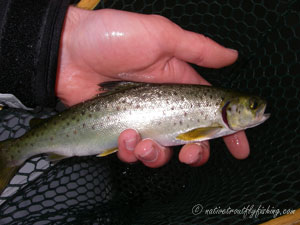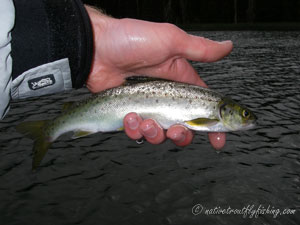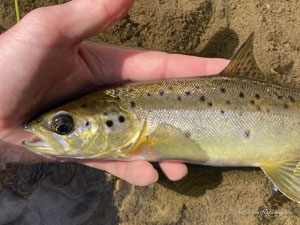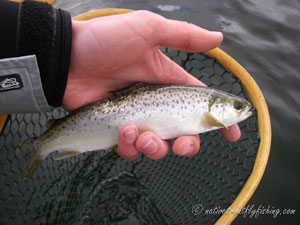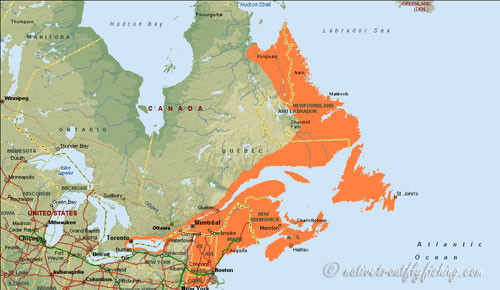Atlantic Salmon
Salmo salar
A beautiful landlocked Atlantic Salmon caught during its fall migration in northern Maine.
Introduction
Atlantic Salmon are the only member of the genus Salmo native to North America and historically ranged from Connecticut to Northern Quebec Canada. However, they have vanished from most of the Eastern United States due to a variety of issues such as habitat destruction and overfishing. Atlantics are often considered one of the most prestigious fish to pursue and are well known for their fighting ability. Adding to the draw for anglers Atlantic Salmon are capable of reaching large sizes with the largest fly caught North American fish weighing in at over 70lbs.
Life History Information
When most people hear the name Atlantic Salmon, they think of the large anadromous fish of the coastal rivers of Northeastern North America and Europe. However, these fish also occur as a landlocked forms that may exhibit either stream resident or more commonly lacustrine life histories. Anadromous Atlantic Salmon fit a similar role to steelhead and as such have never been as abundant as what Pacific salmon are on the west coast of America. Atlantics are fall spawning fish, with most spawning occurring between mid-October and mid-November. However, fish may begin returning to their natal rivers on their spawning runs as early as April or May during the higher spring flows. The largest fish are typically first to return, while smaller younger fish will often return later in June or July (Behnke 2002). Spawning takes place at lower end of riffles where the water is well oxygenated (Danie 1984). Atlantic Salmon show a great level of variability in their size and age at maturity, with most Atlantic Salmon return to spawn after two or three years at sea when they weigh between 10 and 20lbs, but some return after only a single year at sea. These smaller fish are known as grilse and typically weigh between 3-6lbs (Behnke 2002). Unlike Pacific Salmon and Steelhead jacks, grilse are often both males and females and the proportion of older fish to grilse varies greatly from river to river. Alternatively, some male fish may mature and spawn before going to sea, when they are still in the parr stage (Fleming 1996). With this strategy, instead of fighting for access to females, these parr use a "sneaker" tactic and wait till spawning begins then rush in and fertilize the eggs. Where the five species of Pacific Salmon die after spawning, Atlantics may live to spawn multiple times, although most do end up dying after their first spawning event.
Juvenile Atlantic Salmon hatch after between 175 and 200 days under normal conditions, with fry emerging from the gravel about six weeks later (Danie et al. 1984). Depending on the latitude this may be between March and June and once they emerge the fry they establish territories and begin foraging for food. Juveniles may remain in their natal stream for between one and eight years of age before smolting and heading out to sea at a size of between 5" and 7". Once at sea, North American Atlantic Salmon are highly migratory and tend to head for the Labrador Sea, coast of Greenland or Straits of Denmark (Friendland et al. 1993). Atlantics at sea are opportunistic feeders and have a diet consisting primarily of fish and crustaceans. These fish will forage until ready to begin their spawning runs, at which time they will return to their natal stream.
It is thought that landlocked at Atlantic Salmon came from fish of anadromous origin that were isolated above migration barriers during the last ice age (Caldwell 2003). However, some populations of resident Atlantic Salmon also simply coexist among populations of anadromous fish as well (Fleming 1996). The most common landlocked life history in North America are adfluvial fish. These fish are similar to anadromous Atlantics in their spawn timing and behavior. Adfluvial Atlantics require cold lakes that have streams with ample spawning habitat flowing into them (VFW 2007). Generally these fish will attain sizes of between 13" and 21" but when forage fish are available they may grow to be more than 5lbs (Behnke 2002). One of the oddest life histories exhibited by Atlantic Salmon is a dwarf population that occurs in a small stream in Newfoundland above a barrier fall. These fish mature at an age of 1 to 3 years old, when there are only 3 1/2" to 4" long (Gibson and Haedrich 2006). Brook Trout also occur in this stream, holding primarily in the pools and feeding heavily on adult aquatic and terrestrial insects. The Salmon on the other hand head in the faster riffles and mainly fed on the nymph stage of insects (Gibson et al. 1996).
Status
As with other North American anadromous fish, Atlantic Salmon have seen substantial declines since the arrival of Euro-Americans within their native range. These fish once inhabited rivers from the Housatonic in Connecticut, north the watersheds of Ungava Bay in Northern Quebec. Although Atlantics were never as abundant as Pacific Salmon, there are a number of historic records that indicate that they were once quite prolific and t is estimated that between 300,000 and 500,000 fish returned to watersheds with in the United States annually (Fay et al. 2006). However, Atlantic Salmon were not immune to over exploitation and disappeared quickly across the United States with the onset of the industrial revolution. Today the strongest remaining populations of North American Atlantic Salmon are found in remote parts of Northeastern Canada and populations within the United States are all but extinct. The last remaining populations in the US are found in several Maine streams, but these fish have been listed as threatened under the Endangered Species act. Landlocked populations of Atlantic Salmon have fared much better than anadromous ones and while some populations have been lost, overall landlocked Atlantics are actually found in more watersheds today due to stocking.
A number of causes can be attributed to the decline of Atlantic Salmon across America and these include, overfishing, pollution and dams. Over-fishing has been problematic since Europeans first settled in America. Early reports of settlers harvesting Atlantic Salmon by the wagon load just to fertilize their fields were rather common. This over-fishing, whether it be legal or not has continued to the present day. In the 1970's for example the feeding grounds of North American and European Atlantic Salmon were discovered off the coast of Greenland and in 1971 alone nearly 6 million pounds of these fish were harvested (Behnke 2002). Since these overzealous catches, there have been major reductions in the amount of salmon allowed to be harvested in this fishery. The North Atlantic Salmon Conservation Organization helps manage the quotas for this fishery and today only 1-2% of the total Atlantic Salmon catch comes from the Greenland fishery (NASCO 2011). With declining catches in Atlantic Salmon, aquaculture has become the source of many of the salmon the reach the market. However, this is not without impacts on wild populations either. Fish farms are a major source of disease and parasite infections for wild fish. Beyond this, escapees from these farms often end up breeding with wild fish and it is likely that the majority of the salmon returning to New England rivers are of farmed origin or at least have some genes from farmed fish.
One of the earliest major problems to face Atlantic Salmon on the east coast of North America, was the construction of dams. Dams have been built on most of major rivers in New England, such as the Connecticut River, which was dammed in its lower reaches in 1798, barring Atlantics access to the entire watershed. Habitat destruction and pollution have also been exceptionally harmful to Atlantic Salmon. Logging has been one such form of habitat destruction and increased water temperatures and siltation are two of the more harmful impacts that can be directly linked with logging. Fairchild et al. (1999) also showed that salmon returns dropped significantly in watersheds sprayed with a pesticide used by the timber industry to control the spruce budworm. These watersheds also showed unusually high smolt mortality during the same period. Acid precipitation from sources such as coal burning power plants in the Midwest has also been problematic and the associated increased acidification in streams containing Atlantic Salmon has been responsible for lower survival rates in juveniles (NMFS and USFWS 2005). These are just a few of the problems facing Atlantic salmon, but recovery efforts are underway in many of the Atlantic Salmon's native waters.
With the listing of Atlantic Salmon in 2000 as endangered under the US Endangered Species Act, these fish have received extra protection, and the USFWS and NMFS are taking steps to restore depleted populations across New England. While many of the rivers that these fish were native to still have dams on them, dam removal efforts have begun in some watersheds. On the Penobscot River in Maine, which has received about 90% of all of New England the wild salmon in recent year, two dam removal projects and one fish passage project are planned to open up hundreds of miles of access to spawning fish (Trout 2007). There are also efforts underway to reintroduce Atlantic Salmon to the larger New England rivers such as the Connecticut. While these efforts have met with limited success, as of July 2011 106 adult salmon had returned to the Connecticut River (CRSA 2011). Although some progress has been made in the effort to restore Atlantic Salmon, it is an uphill battle and the diversity that was once found in the now extinct runs of New England is lost forever. Luckily some strong populations still remain in the Northern part of their range, where man has had a lesser impact on them and their environment.
Description
Atlantic Salmon are similar in appearance to brown trout, but tend to have a more streamlined body profile. Atlantics have slim bodies and their caudal peduncle is slender and the caudal fin itself is typically somewhat squared. Atlantics in freshwater tend to have red spots along their lateral line and black spots primarily above the lateral line. Spots are irregular shaped and some may be x-shaped and are typically somewhat sparse. The coloration of juvenile Atlantic Salmon in streams is brownish on the back and transitions to a yellow-brown along the belly. Adfluvial and anadromous fish acquire a silvery coloration, but as spawning comes on they will take on a golden-brown color along the sides. Males develop a kype, more intense coloration and dense maroon colored spots as they prepare to spawn.
Adfluvial Form
Click on images to view a larger picture
Contact
Feel free to contact me if you have any questions or comments
Native Trout Links
Truchas Mexicanas' - Native Trout of Mexico
Balkan Trout Restoration Group
Trout and Seasons of the Mountain Village - About Japanese Trout
Western Native Trout Challenge
California Heritage Trout Challenge
Fly Fishing Blogs
Dave B's Blog: Fly Fishing for Native Trout
The Search for Native Salmonids
Conservation Links
Western Native Trout Initiative
Fly Fishing Links
Fishing Art Links
Americanfishes.com - Joseph R. Tomelleri

